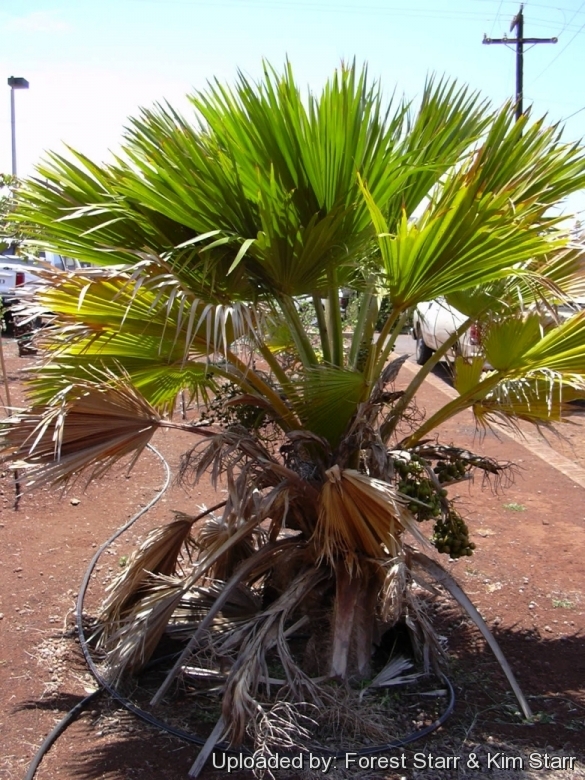
Pritchardia glabrata Photo by: Forest Starr & Kim Starr
Habit at State nursery Kahului, Maui, Hawaii (USA). May 23, 2003.
Origin and Habitat: Pritchardia glabrataSN|24625]]SN|24625]] is Endemic of Maui, Hawaii islands, USA
Altitude: It grows at around 500-550 metres A.S.L.
Habitat: Pritchardia glabrataSN|24625]]SN|24625]] is found naturally in the vicinity of ʻĪao Valley, West Maui on steep slopes and gulches in moist open forest and mesic scrubland.
Synonyms:
See all synonyms of Pritchardia glabrata
back
Accepted name in llifle Database:Pritchardia glabrata Becc. & RockMem. Bernice Pauahi Bishop Mus. 8: 42 (1921)Synonymy: 3
back
Common Names include:
ENGLISH: Hawaiian Fan Palm
HAWAIIAN (ʻŌlelo Hawaiʻi): Wāhane, Noulu, Loulu, Hāwane
Description: Pritchardia glabrataSN|24647]]SN|24625]] is an excellent very slow growing miniature fan palm. It is said to be the smallest Hawaiian pritchardia known. It is rarely seen in garden cultivation but highly ornamental.
Trunk. 1-2(-6?) m tall, ca. 15-20 cm in diameter, columnar, slender, naked, smooth or fibrous when young, longitudinally grooved, and obscurely ringed by leaf scars.
Crown: Canopy open, with ca. 12-16 leaves; width is 3-4 metres.
Leaves: Wavy about 65-75 cm long from ligule to leafl-tip; Leaflets up to 70 cm long, chartaceous, strongly folded (irrespective of plications), finely but not deeply split and the split parts are pendant, even in short palms, green above and below, and dotted below with tiny round transparent scales; Petioles smooth and devoid of scales about 40 cm long.
Flower: Inconspicuous, pale white to yellowish .
Blooming season: Autumn to winter.
Fruit: Numerous small, globose or ovoid, 21-24 mm long 16-20 mm wide, on fruit stalks as long as the leaf stalks (petioles).
Remarks: Pritchardia ellipticaSN|24625]]SN|24627]] and Pritchardia lanaiensisSN|24626]]SN|24626]], are often considered as synonyms of Pritchardia glabrataSN|24627]]SN|24625]]. It is said to belong to the Pritchardia remotaSN|24625]]SN|24647]] complex.
Bibliography: Major References and further lectures
1) Wikipedia contributors. "Pritchardia glabrata." Wikipedia, The Free Encyclopedia. Wikipedia, The Free Encyclopedia, 17 Mar. 2013. Web. 3 Sep. 2014.
2) Forest & Kim Starr Pritchardia glabrata (Loulu). Plants of Hawaii. <http://www.starrenvironmental.com>. Downloaded on 21 August 2014.
3) Palmpedia contributors. "Pritchardia glabrata." Palmpedia, PALM ENCYCLOPEDIA, <http://www.palmpedia.net> Downloaded on 26 Aug. 2014
4) Donald R. Hodel "Loulu-The Hawaiian Pritchardia" in the: The Palm Journal 193, page 12.
5) Native Plants Hawaii. “Pritchardia forbesiana” web 21 August 2014. >http://nativeplants.hawaii.edu>
6) David Leaser "Growing Palm Trees in Hawaiʻi and Other Tropical Climates"
Don Ellison, Anthony Ellison “Cultivated Palms Of The World” UNSW Press, 01/May/2001
7) Gemmill, C. 1998. Pritchardia glabrata. The IUCN Red List of Threatened Species. Version 2014.2. <www.iucnredlist.org>. Downloaded on 03 September 2014.
8) http://donselman.homestead.com/page8.html
9) http://www.pacsoa.org.au/palms/Articles/minerals.html
10) Hawaiian Dictionaries http://www.wehewehe.org/
11) Donald R. Hodel "A Review of the Genus Pritchardia", pages S-3, S-8, S-14-15.
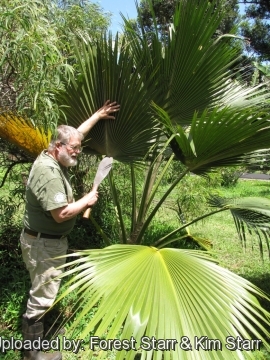 Habit with Bob at Pololei Haiku, Maui, Hawaii (USA). April 11, 2013. Photo by: Forest Starr & Kim Starr
Habit with Bob at Pololei Haiku, Maui, Hawaii (USA). April 11, 2013. Photo by: Forest Starr & Kim Starr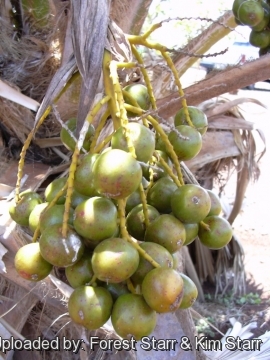 Fruit at State nursery Kahului, Maui, Hawaii (USA). May 23, 2003. Photo by: Forest Starr & Kim Starr
Fruit at State nursery Kahului, Maui, Hawaii (USA). May 23, 2003. Photo by: Forest Starr & Kim Starr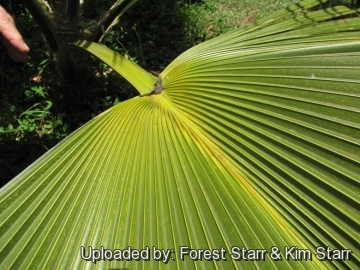 Frond at Pololei Haiku, Maui, Hawaii (USA). April 11, 2013. Photo by: Forest Starr & Kim Starr
Frond at Pololei Haiku, Maui, Hawaii (USA). April 11, 2013. Photo by: Forest Starr & Kim Starr Frond fur at base at Pololei Haiku, Maui, Hawaii (USA). April 11, 2013. Photo by: Forest Starr & Kim Starr
Frond fur at base at Pololei Haiku, Maui, Hawaii (USA). April 11, 2013. Photo by: Forest Starr & Kim Starr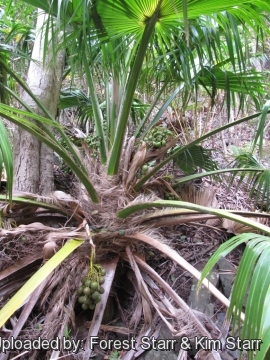 Fruit at Iao, Maui, Hawaii (USA). April 30, 2010. Photo by: Forest Starr & Kim Starr
Fruit at Iao, Maui, Hawaii (USA). April 30, 2010. Photo by: Forest Starr & Kim Starr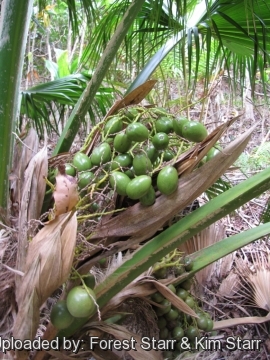 Fruit at Iao, Maui, Hawaii (USA). April 30, 2010. Photo by: Forest Starr & Kim Starr
Fruit at Iao, Maui, Hawaii (USA). April 30, 2010. Photo by: Forest Starr & Kim Starr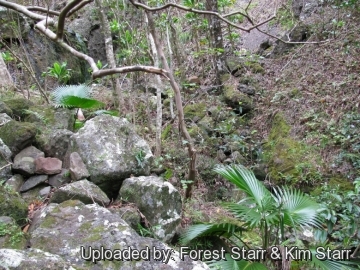 Habit at Iao, Maui, Hawaii (USA). April 30, 2010. Photo by: Forest Starr & Kim Starr
Habit at Iao, Maui, Hawaii (USA). April 30, 2010. Photo by: Forest Starr & Kim Starr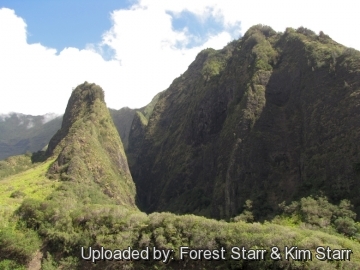 Habitat with Iao Needle at Iao, Maui, Hawaii (USA). April 30, 2010. Photo by: Forest Starr & Kim Starr
Habitat with Iao Needle at Iao, Maui, Hawaii (USA). April 30, 2010. Photo by: Forest Starr & Kim StarrCultivation and Propagation: Pritchardia glabrataSN|24625]]SN|24625]] is an easy, but very slow growing palm that likes sandy organic soil, but is adaptable to clay and loam bolth slightly alkaline and acidic. Good drainage is also important. Pritchardia glabrataSN|24625]]SN|24625]] vary in shape. Specimens raised in dry and/or infertile soils tend to be smaller in stature with smaller leaves. Light also affects the plant's form while those grown in full sun are more compact.
Fertilization: Need a perfect fertilizer diet including all micro nutrients and trace elements or slow release fertilizer. Micronutrient deficiencies are occasional problems. If it doesn't get enough magnesium (Mg), manganese (Mn), potassium (K9 and iron (Fe) is indicated by yellowing leaves (chlorotic). Micronutrient deficiencies only show up on soil with a high pH. Fertilize often for faster growth. Potted or younger loulu planted in the ground appreciate a foliar feeding monthly or bi-monthly.
Water Requirements: Needs regular water, do not let dry out between waterings. however it does not want to sit in continually wet, mucky soil. The roots and lower trunk can rot if soil is kept too moist.
Light: Prefers full sun but will tolerate half day sun.
Hardiness: It is adapted to tropical and subtropical climates but tolerate and can't stand temperatures below zero; they should be grown in cold green houses or at least in a place where they are sheltered by the wind; However mature specimens can endure temperatures down to about -4°C (for short periods), while young plants are more cold sensitive.
Maintenance: The dead leaves, flowers and fruits can be removed in a landscape setting for a cleaner appearance. Do not prune the fronds that still have some green colour. Palms recycle nutrients from dead or dying fronds and use them for healthier fronds. Palms only have a set number of new leaves that can sprout and grow per year and removing fronds will not increase that number. If you cut off more than what will grow annually, you could be left with a pretty bare and bald palm.
Wind and salt tolerance: This palm is wind and somewhat salt aerosol tolerant, but does a lot better inland then it does on the coast. With a particularly windy climate it is suggested to secure young palm to long solid stakes, to avoid that the wind could bare young and not very developed roots; specimens which are only a few years old might fear intense wind.
Pest & diseases: It is prone to leaf rollers, red spider mites and sugar cane borers. Rats will eat the fruit.
Early Hawaiian Use The hard wood of the trunk were fashioned into spears. The trunks loulu were notched for climbing to gather the immature fruits and fronds. Older specimens still bear notches that can be seen today. The fronds were used for thatching and as plaiting such as papale (hats) and fans.
Food use: The young fruits called hāwane or wāhane are edible and can be eaten after being peeled. The flavour of fruit with the soft interior is similar to coconut.
Ornamental: It is cultivated as an ornamental tree, and planted in gardens and parks in tropical and sub-tropical climates either as a single specimen or in groups. Culture in containers is possible although growth rates are slower. A bright patio will provide an excellent environment for young specimens which can eventually be planted in a sunny location.
Propagation: Mature seeds buried half way in pot of clean, well drained potting soil, water daily, sprout in a few months, plants of 1 foot can be put in ground/larger pot; Because these palms easily hybridize with other Pritchardias, claiming a specific species requires seed collection from wild populations.

















